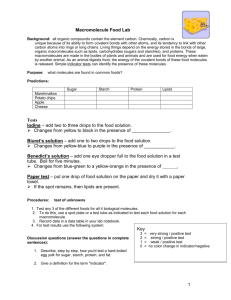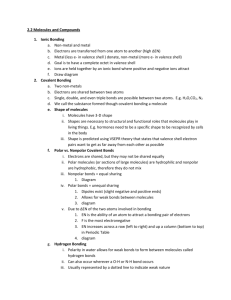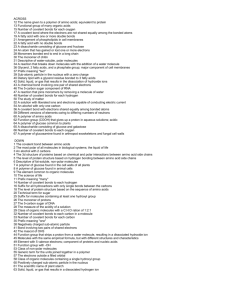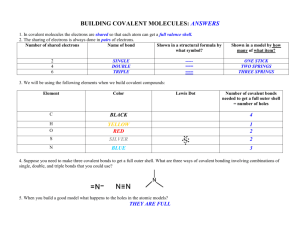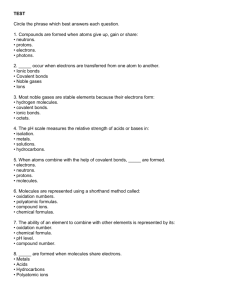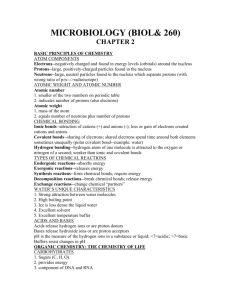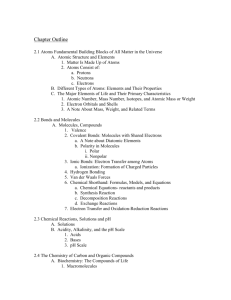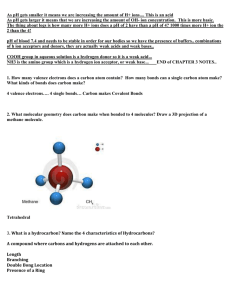Chapter 2: The Chemical Level of Organization
advertisement
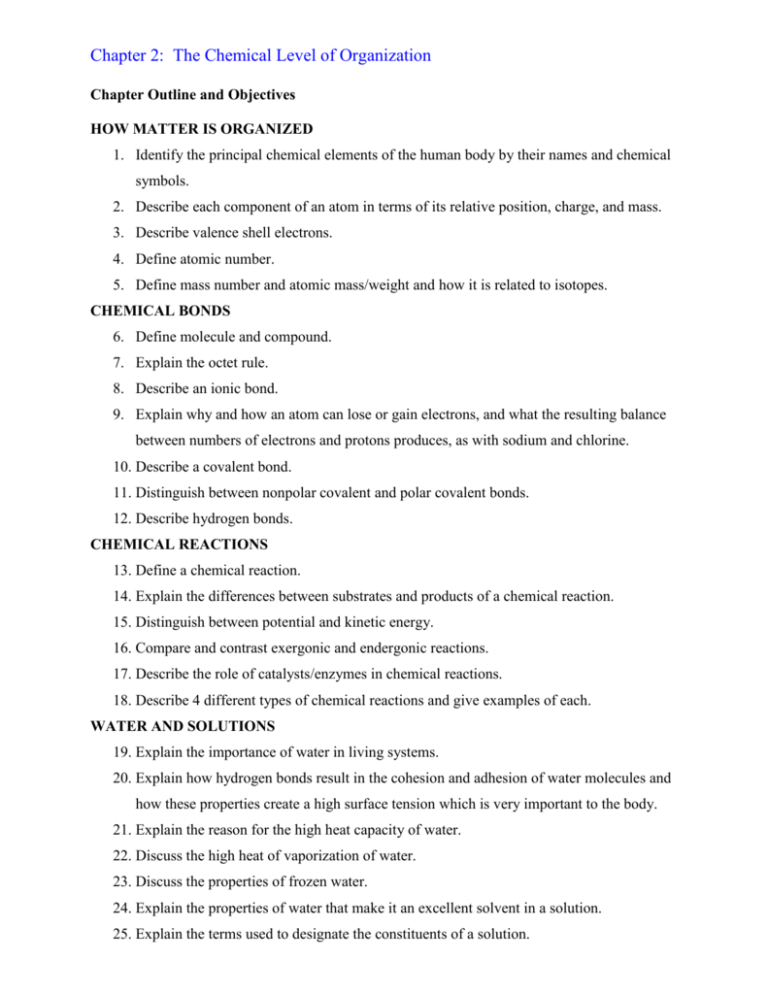
Chapter 2: The Chemical Level of Organization Chapter Outline and Objectives HOW MATTER IS ORGANIZED 1. Identify the principal chemical elements of the human body by their names and chemical symbols. 2. Describe each component of an atom in terms of its relative position, charge, and mass. 3. Describe valence shell electrons. 4. Define atomic number. 5. Define mass number and atomic mass/weight and how it is related to isotopes. CHEMICAL BONDS 6. Define molecule and compound. 7. Explain the octet rule. 8. Describe an ionic bond. 9. Explain why and how an atom can lose or gain electrons, and what the resulting balance between numbers of electrons and protons produces, as with sodium and chlorine. 10. Describe a covalent bond. 11. Distinguish between nonpolar covalent and polar covalent bonds. 12. Describe hydrogen bonds. CHEMICAL REACTIONS 13. Define a chemical reaction. 14. Explain the differences between substrates and products of a chemical reaction. 15. Distinguish between potential and kinetic energy. 16. Compare and contrast exergonic and endergonic reactions. 17. Describe the role of catalysts/enzymes in chemical reactions. 18. Describe 4 different types of chemical reactions and give examples of each. WATER AND SOLUTIONS 19. Explain the importance of water in living systems. 20. Explain how hydrogen bonds result in the cohesion and adhesion of water molecules and how these properties create a high surface tension which is very important to the body. 21. Explain the reason for the high heat capacity of water. 22. Discuss the high heat of vaporization of water. 23. Discuss the properties of frozen water. 24. Explain the properties of water that make it an excellent solvent in a solution. 25. Explain the terms used to designate the constituents of a solution. 26. Define acids and bases. 27. Define pH in terms of hydrogen and base (hydroxide) ion concentration and be able to recognize acidic and alkaline solutions in terms of pH values. 28. Define a buffer in terms of its ability to prevent large changes in [H+] due to strong acids and bases, in addition to the general mechanism. ORGANIC COMPOUNDS 29. Describe the functional groups of organic compounds. 30. Discuss the fact that many organic molecules are macromolecules which are polymers formed by linking together monomers. 31. Distinguish between hydrolysis and dehydration synthesis. Carbohydrates 32. List the major forms of carbohydrates (sugars, starches, glycogen, cellulose, and chitin), and describe their functions. 33. Discuss what is meant by a monosaccharide. 34. Discuss how disaccharides and polysaccharides are formed. Lipids 35. Discuss the chemical makeup and properties of lipids. 36. Discuss the properties of triglycerides and their function. 37. Discuss the properties of saturated and unsaturated fatty acids. 38. Describe the structure, and role in the body, of phospholipids. 39. Describe the structure of steroids and list members of the steroid class of lipids. 40. Discuss the lipid transport mechanism in the body. 41. Describe the structure and function of eicosanoids. 42. List the “other” lipids. Proteins 43. Describe the basic amino acid structure, the groups of amino acids, and how amino acids are joined to form polypeptides. 44. Describe how a chain of amino acids interacts with itself to produce the four levels of structural organization. 45. List the functional and structural categories of proteins and members of each group. Nucleic Acids: Deoxyribonucleic Acid (DNA) and Ribonucleic Acid (RNA) 46. Note the two general types of nucleic acids (DNA and RNA). 47. List the components of a nucleotide. 48. List the five nitrogenous bases and whether they are in DNA or RNA or both. Explain how the nitrogenous bases interact in DNA and RNA structure. Adenosine Triphosphate 49. Discuss the structure and function of ATP. Chapter Lecture Notes Elements Elements – cannot be reduced to simpler substances by normal chemical means (Table 2.1) Atoms – smallest complete unit of an element Subatomic particles – building blocks of atoms (Fig 2.1) Protons (+) Neutrons (neutral) Electrons (-) Nucleus of an atom is comprised of neutrons and protons and therefore has a + charge; electrons (-) are attracted to the nucleus and move around the nucleus in orbitals which are grouped into shells 1st shell – holds 2 e2nd shell – holds 8 e3rd shell – holds 8 eouter shell = valence shell (valence is = number of extra or deficient e- in outermost shell) Arranged in periodic table by symbols, along with atomic number and atomic mass/weight (Fig 2.2) Atomic number = number of protons = number of electrons (in a neutral atom) atomic number determines which element is in question Mass number = number of protons + number of neutrons (whole number) mass (weight) of protons or neutrons is 1840 x larger than that of e-, so number of electrons is ignored Isotopes - elements with the same # of protons but a varying # of neutrons element with the same atomic number but a different mass number Radioisotopes – unstable isotopes that emit energetic particles All elements with atomic number > 84 are radioactive but these elements are not normally present in biological material Atomic Mass (Weight) = a ratio of the average mass of isotopes of an element from a single given sample (number with decimals) Molecules & Compounds Molecules - chemical combination of 2 or more atoms of one or more elements chemically bonded together (Fig 2.5) atoms don't have to be different H2 is a molecule as is H2O Compounds - 2 or more different elements joined together Chemical Bonding Electrons are the part of an atom that actively participates in a chemical reaction (never the nucleus) (Fig 2.5) Chemical behavior of atoms can be explained by behavior of electrons Octet rule: atoms react with one another to achieve 8 e- in outer shell (except 1st shell) Atoms with fewer than 8 electrons in valence shell may transfer or share electrons to complete outer shell When atoms transfer or share electrons in their valence shells, they are attracted to each other by chemical bonds Types of Chemical Bonding Ions - atoms that are electrically charged either by gaining or losing electrons (Table 2.2) Ionic bond – formed when electrons are transferred from one atom to another; the bond is therefore the electrical attraction between 2 oppositely charged ions (Fig 2.4) compounds containing ionic bonds readily separate (dissociate) into ions in water and are called electrolytes because as charged particles they can conduct an electric current examples of electrolytes are acids, bases, and salts if outer (valence) shell has 1,2, or 3 e-, the atoms tend to lose the electron and become + ions, which are called cations if outer (valence) shell has 6 or 7 e-, the atoms tend to gain electrons and become – ions, which are called anions if outer (valence) shell has 4 or 5 e-, they don't tend to form ions; they tend to share electrons and form covalent bonds Covalent bond – results from sharing valence electrons (Fig 2.5) covalent compounds tend to be nonelectrolytes carbon has 4 electrons in outer shell and needs 4 more electrons so it normally forms covalent bonds More different compounds containing carbon than any other element Nonpolar covalent - equal sharing of electrons; no charged regions (Fig 2.5a-d) Polar Covalent - electrons are not equally shared; results in charged regions (Fig 2.5e) water is a good example of a polar covalent compound oxygen is more electronegative (tendency to attract electrons) than hydrogen Hydrogen or H bonds - weak attraction between a slightly + hydrogen and a slightly - oxygen or nitrogen H bonds can be between molecules (intermolecular; as in water) or within molecules (intramolecular; as in DNA and protein) (Fig 2.6) H bonds are significantly weaker than covalent or ionic bonds Chemical Reactions Chemical Reactions – the making and breaking of chemical bonds (Fig 2.7) Reactants – starting materials in a reaction Products – ending materials in a reaction Energy - the capacity to do work Kinetic energy – the energy of motion Potential energy - the energy that matter possesses because of its location or structure, stored energy Exergonic reaction - a reaction that proceeds with a net release of energy (Fig 2.8) Endergonic reaction - a reaction that absorbs energy from its surroundings Catalyst - a chemical agent that changes the rate of a reaction without being consumed by the reaction (Fig 2.9) lowers the activation energy needed for a reaction to occur Enzymes - catalytic proteins (Fig 2.23) substrate - the material or substance on which an enzyme acts active site - area of enzyme where substrate attaches enzyme + substrate = product + enzyme Types of Chemical Reactions Anabolism (Synthesis reaction) - reactions that consume energy to build complicated molecules from simpler ones Catabolism (Decomposition reaction) - reactions that break down complex molecules into simpler compounds Reversible reactions Exchange reactions Water Water - extraordinary liquid because of its intermolecular hydrogen bonds H2O has an unusually high surface tension because of collective strength of its H bonds surface tension - measure of how difficult it is to break the surface of a liquid pins/needles can float on water; certain insects can walk on H2O Capillary action – H2O moves up a capillary tube or between 2 glass slides because H2O molecules stick together Adhesion - molecules sticking to other molecules Water to glass Cohesion - holding together of molecules of the same substance Water to water Resistance to change in temperature temperature of water rises and falls more slowly than other liquids the many H bonds that hold water together help water absorb heat without a change in temperature requires 1 calorie of heat energy to raise 1 gram of water 1° C, which is about 2x what other covalent liquids require Resistance to change is temperature is an advantage to organisms living in water High water content of terrestrial plants and animals help them maintain a relatively constant internal temperature Has high heat of vaporization Heat of vaporization - amount of heat a liquid must absorb for 1 gram of it to be converted from liquid to gas water - 540 calories ethyl alcohol - 237 calories acetone -125 calories changing from liquid to gas requires that H bonds be broken the H bonds make it difficult for molecules of water to make exodus from liquid to gas when water evaporates it takes a lot of heat energy along with it and gives the surface a cooling effect evaporation of water from terrestrial plants and animals is chief way these organisms unload excess heat and stabilize internal temperature Freezing Water Motion of molecules slows as temperature decreases and molecules come closer together so that water molecules can now form H bonds with 4 other molecules This creates an open latticework which takes up more space so water expands when it freezes; therefore ice floats on lakes/ponds/rivers Water freezes from top to bottom and allows life to continue beneath Adding solutes like NaCl to water decreases the freezing point because salt interferes with H bonding—it is a physical interference that prevents H bonds from occurring as readily Water is one of only a few substances that is less dense as a solid than as a liquid Water is most dense at 4° C (water expands as temperature decreases below 4° C) Water is a versatile solvent because of polarity of water molecule solvent + solute = solution polar water molecules separate ionic substances such as NaCl into ions (Fig 2.10) polar molecules (ammonia, some proteins, carbohydrates) tend to dissolve in water nonpolar (like fats) molecules do not dissolve well in water H bonds act to exclude nonpolar molecules Acids - substances that release H+ when they dissociate in water (proton donors) strong acids - dissociate readily because of electronegativity of anion (Fig 2.11) HCl→H+ + Clweak acids - don't dissociate readily H2CO3→ H+ + HCO3- (only 1 % dissociation) Bases – substances that release OH- or accept H+ when they dissociate in water (proton acceptors) may be strong (NaOH) or weak (amino group) Salts – can be made chemically by an exchange reaction with a strong acid and strong base strong acid + strong base→ salt and H2O pH - measure of H+ concentration (Fig 2.12 & Table 2.4) Buffers - substances that minimize (resist) change in pH works by accepting H+ when in excess and donating H+ when depleted buffers are generally a mixture of weak acid and a weak base Functional Organic Groups Functional organic groups - regions of organic molecules most commonly involved in chemical reactions (Table 2.5) compounds that contain the functional groups tend to result in a polar compound that dissolves in water Hydroxyl – alcohols Sulfhydryl – thiols Carbonyl – aldehydes and ketones Carboxyl – carboxylic acids Ester Phosphate Amino - amines Organic Compounds Organic compounds - any substance that contains both carbon and hydrogen Polymer - long chain of a repeating molecular unit (Fig 2.21) monomer + monomer → polymer + H2O (dehydration synthesis = condensation) polymer + H2O → monomer + monomer (digestion reaction = hydrolysis) Carbohydrates Carbohydrates (contain C, H, O) = sugars and starches (Table 2.6) most abundant group of organic compounds in all organisms provides most readily available source of energy short term storage of energy in animals Monosaccharides - generally an aldehyde or ketone with several hydroxyl groups (Fig 2.13 & 2.14) Pentose - 5 carbon sugar ribose/deoxyribose of RNA/DNA Hexose - 6 carbon sugar The following are isomers: glucose - (aldehyde) most abundant hexose galactose - (aldehyde) fructose - (ketone) Disaccharides - Monomer + Monomer = disaccharide (Fig 2.15) sucrose =______________+_____________ maltose =_____________ + _____________ lactose = ______________ + _____________ Polysaccharides (Fig 2.16) starches - principal storage polysaccharide in plants potatoes, rice, grain glucose polymer glycogen - principal storage polysaccharide in animals 1 pound stored in liver/skeletal muscle glucose polymer cellulose - found in plant cell walls; the most abundant carbohydrate; digested by protozoans in termites and bacteria in cows constitutes fiber in our diet which stimulates goblet cells to secrete mucus glucose polymer chitin - in exoskeleton of arthropods and insects; in cell walls of fungus modified glucose polymer Lipids Lipids - all tend to be insoluble in water (Table 2.7) Triglycerides (neutral fats) - largest of class of lipids (Fig 2.17) Functions Long term storage - 1 gram of fat stores twice as much energy as 1 gram of carbohydrate Because plants are immobile, they can function with bulky energy storage in the form of starch. Animals, however, must carry their energy baggage with them, so there is an advantage to a more compact storage of fuel Protect and insulate Structure glycerol (monomer) + 3 fatty acids (monomers) → triglyceride fatty acids have a carboxyl group at one end & a long hydrocarbon chain that is hydrophobic (often 16-24 carbons long) glycerol has 3 hydroxyl groups glycerol’s hydroxyl groups can react with a fatty acid’s carboxyl group and form an ester linkage saturated fats – all bonding sites of the fatty acid are filled with hydrogen saturated fats may cause increased deposits of cholesterol along arterial walls animal fats - tend to be saturated and solid at room temperature unsaturated fats - some double bonds present so not all bonding sites are filled with hydrogen and the fatty acid has a kink in its shape, preventing solidification plant fats (corn, canola, peanut, olive, sesame) - tend to be unsaturated and oils at room temperature (exception - palm & coconut) some vegetable oils are partially hydrogenated to make margarine, Crisco shortening, peanut butter Phospholipids - in cell membranes and membranes of organelles (Fig 2.18) consists of glycerol + 2 fatty acids + phosphate group (- charge) fatty acid tail - hydrophobic = insoluble in water phosphate head - hydrophilic = soluble in water phospholipids are arranged as a bilayer with phosphate heads toward water (outside of bilayer in contact with aqueous (water) solutions inside and outside the cell) and the fatty acid tails toward the interior of the membrane Steroids (Fig 2.19) Cholesterol precursor from which most other steroids are synthesized cholesterol is found in all cell membranes (keeps membranes from dissolving) consists of 4 fused carbon rings Sex hormones - estrogen, progesterone, testosterone Adrenocorticotropic hormones cortisol - needed for stress control aldosterone - needed to regulate salt and water balance Vitamin D made in skin upon exposure to UV radiation Vitamin D needed for calcium metabolism Bile salts - aid in digestion of lipids Lipid Transport Cholesterol and triglycerides travel in the blood combined with protein in structures called lipoproteins. Lipids are insoluble in water; proteins are soluble. Lipoproteins are synthesized in liver and contain varying amounts of triglycerides, phospholipids, cholesterol, and protein. The more protein, the more dense (HDL); the more lipid, the less dense (LDL) LDL - delivery trucks - carry dietary cholesterol & newly synthesized cholesterol to cells which have special receptors—if receptors are absent or damaged, excess cholesterol can deposit along arterial walls, causing atherosclerosis HDL - garbage trucks - carry excess cholesterol on one-way trip to liver for degredation and excretion; exercise increases HDL Eicosanoids – Prostaglandins and Leukotrienes produced from fatty acids mimic hormones (many different kinds with conflicting functions) has role in blood clotting, fever, pain, and inflammation aspirin blocks the action of an enzyme involved in prostaglandin formation; therefore, aspirin helps control pain, fever, inflammation, reduces blood clotting Other lipids Vitamin A - in orange pigmented vegetables and fruits; used in vision carotene → Vitamin A (in liver) Vitamin E - in plant products like wheat germ/green leafy vegetables promote wound healing and prevent scarring prevents saturation of unsaturated fatty acids in cell membranes = antioxidant Vitamin K - made in intestine by bacteria; needed for blood clotting Proteins Protein - contain C, H, O, N and some S most abundant organic molecule class in humans (makes up 50% of dry weight) monomer = amino acid (Fig 2.20) 20 different amino acids in proteins polymer = protein (polypeptide chain) amino acids are linked by peptide bonds (covalent bonds) (Fig 2.21) Protein Structure (Fig 2.22) Primary - unique amino acid sequence Secondary – alpha helices and beta pleated sheets Tertiary – hydrophobic interactions and disulfide bridges Quaternary - aggregation of polypeptide subunits Functional Categories of Proteins (Table 2.8) Structural: Collagen (1/3 of protein of body), keratin, microtubules Regulatory: Hormones Contractile: actin and myosin in muscle Immunological Transport: Hemoglobin, myoglobin Catalytic: Enzymes Structural Categories of Proteins Fibrous protein Collagen = 1/3 of protein in vertebrates: in bones, cartilage, tendons, ligaments, soft connective tissue Keratin = hair, nails, epidermis Globular protein Microtubules - spindle fibers, centrioles, cilia Enzymes - catalysts that regulate chemical reactions Antibodies Membrane receptors Nucleic Acids DNA and RNA (Fig 2.24 & Table 2.9) monomer = nucleotide pentose sugar (5-carbon monosaccharide) = ribose/deoxyribose phosphate group nitrogenous base Pyrimidines – cytosine and thymine in DNA; uracil in RNA only Purines – adenine and guanine Adenine pairs with Thymine or Uracil Cytosine pairs with Guanine ATP - Adenosine plus three phosphate groups bonded with high energy bonds Energy currency of the cell (Fig 2.25)
